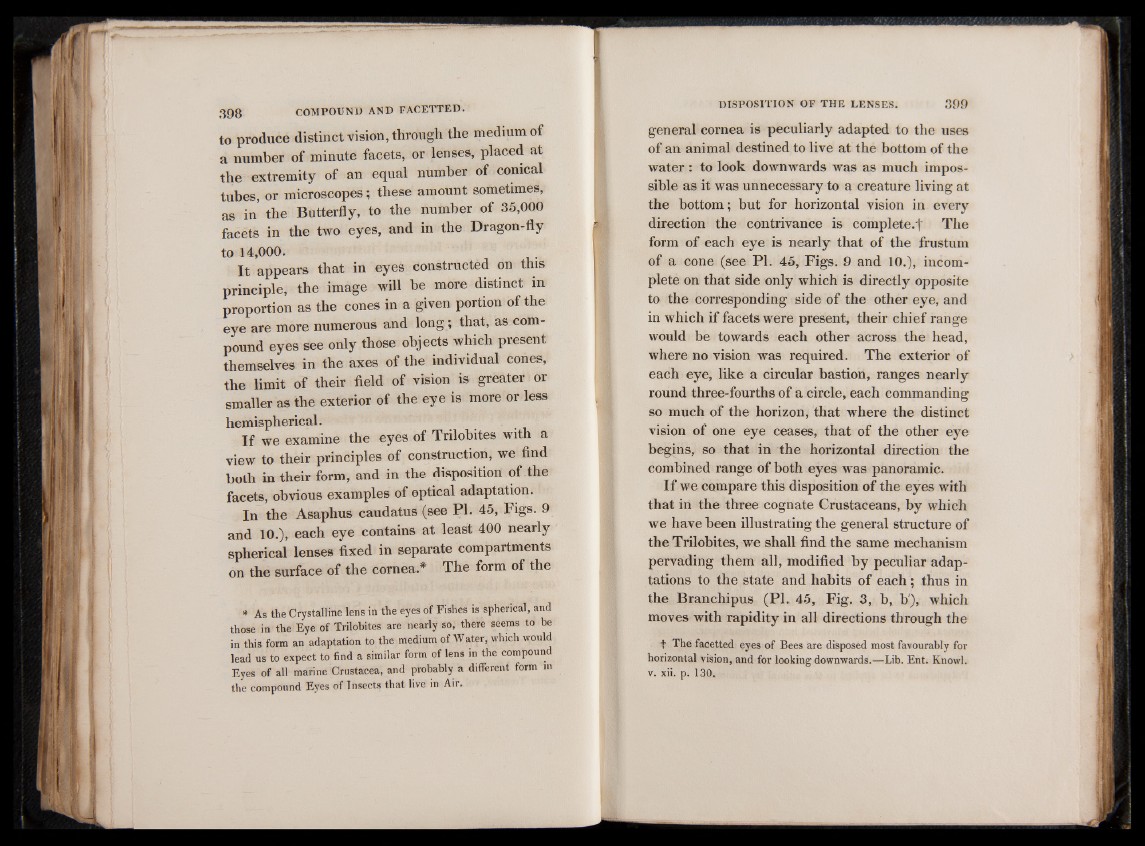
to produce distinct vision, through the medium of
a number of minute facets, or lenses, placed at
the extremity of an equal number of conical
tubes, or microscopes; these amount sometimes,
as in the Butterfly, to the number of 35,000
facets in the two eyes, and in the Dragon-fly
to 14,000.
It appears that in eyes constructed on this
principle, the image will be more distinct in
proportion as the cones in a given portion of the
eye are more numerous and long; that, as compound
eyes see only those objects which present
themselves in the axes of the individual cones,
the limit of their field of vision is greater or
smaller as the exterior of the eye is more or less
hemispherical.
j f we examine the eyes of Trilobites with a
view to their principles of construction, we find
both in their form, and in the disposition of the
facets, obvious examples of optical adaptation.
In the Asaphus caudatus (see PI. 45, Figs. 9
and 10.), each eye contains at least 400 nearly
spherical lenses fixed in separate compartments
on the surface of the cornea.* The form of the
* As the Crystalline lens in the eyes of Fishes is spherical, and
those in the Eye of Trilobites are nearly so, there seems to be
in this form an adaptation to the medium of Water, which would
lead us to expect to find a similar form of lens in the compound
Eyes of all marine Crustacea, and probably a different form in
the compound Eyes of Insects that live in Air.
general cornea is peculiarly adapted to the uses
of an animal destined to live at the bottom of the
water: to look downwards was as much impossible
as it was unnecessary to a creature living at
the bottom; but for horizontal vision in every
direction the contrivance is complete.! The
form of each eye is nearly that of the frustum
of a cone (see PI. 45, Figs. 9 and 10.), incomplete
on that side only which is directly opposite
to the corresponding side of the other eye, and
in which if facets were present, their chief range
would be towards each other across the head,
where no vision was required. The exterior of
each eye, like a circular bastion, ranges nearly
round three-fourths of a circle, each commanding
so much of the horizon, that where the distinct
vision of one eye ceases, that of the other eye
begins, so that in the horizontal direction the
combined range of both eyes was panoramic.
I f we compare this disposition of the eyes with
that in the three cognate Crustaceans, by which
we have been illustrating the general structure of
the Trilobites, we shall find the same mechanism
pervading them all, modified by peculiar adaptations
to the state and habits of each; thus in
the Branchipus (PI. 45, Fig. 3, b, b), which
moves with rapidity in all directions through the
f The facetted eyes of Bees are disposed most favourably for
horizontal vision, and for looking downwards.—Lib. Ent. Knowl.